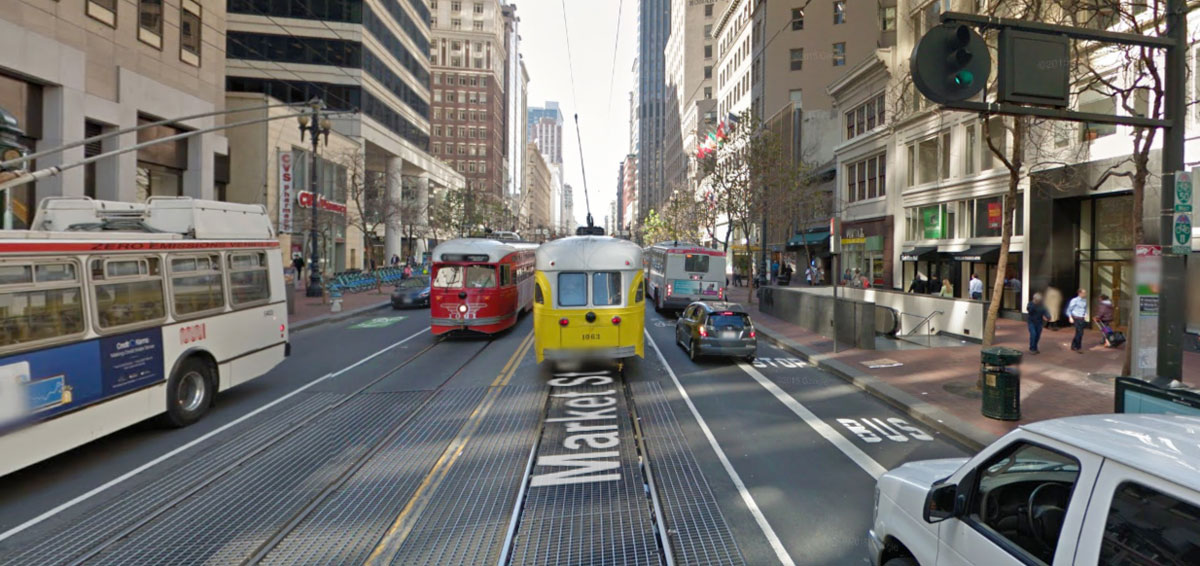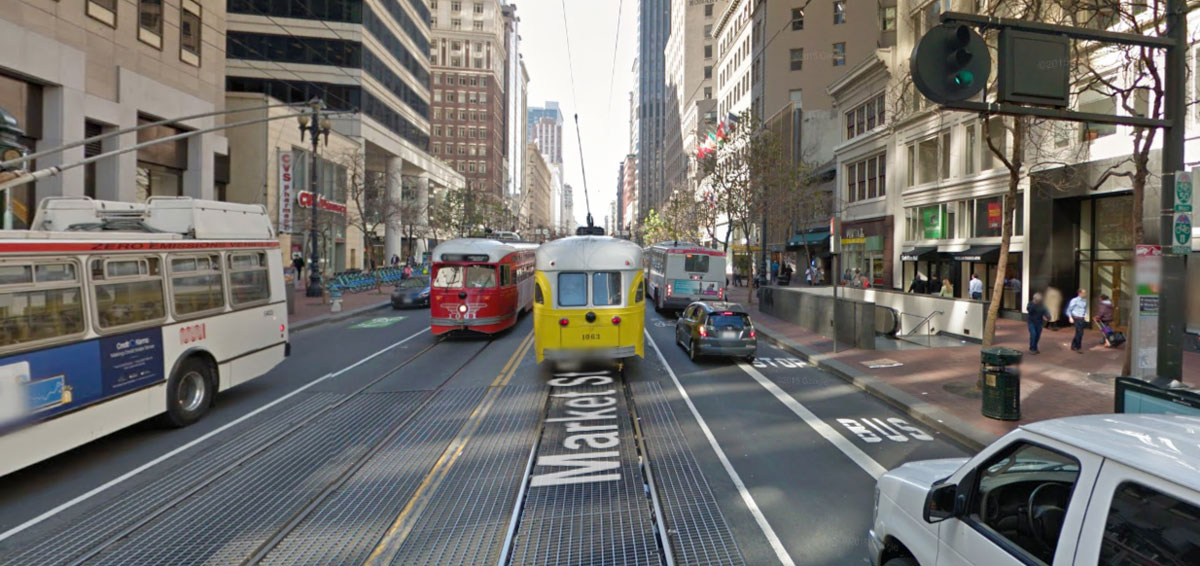Livable City’s Livable Downtown Initiative seeks to make Downtown San Francisco a more vital, sustainable, and livable place.
It has been over twenty years since the city’s landmark Downtown Plan was adopted. The Downtown plan set out to create a vital downtown office and shopping district oriented to walking and public transit.
The vision of a walkable and transit-oriented downtown has mostly proved successful. During the 1980s, office employment grew dramatically, and this increase in employment was largely decoupled from increases in driving and parking. As a result, Downtown San Francisco is one of the best transit-served employment centers in the country, and enjoys one of the highest rates of transit ridership. The 1990s saw a significant increase in regional transit service into the downtown, with the extension of three BART lines and the expansion of Caltrain service.
Despite these successes, there are a number of ways in which Downtown could do be better:
- Despite the large number of residents, workers and visitors who walk and take public transit, Downtown streets are still dominated by auto traffic, and many Downtown streets are poorly designed for walking, cycling, and public transit.
- Thousands of new housing units are being built downtown and in the neighborhoods surrounding downtown, but much of it is out of the financial reach of most San Franciscans.
- Downtown and the surrounding neighborhoods lack many of the basic amenities, including as shops, schools, and open spaces, of livable neighborhoods.
- While major investments have been made to expand regional public transit service into the downtown over the past three decades, many neighborhoods inside and outside the city still lack timely and reliable transit service into downtown.
The goal of Livable City’s Downtown Initiative is to develop a new consensus around the future of downtown, focused on creating a livable and sustainable downtown neighborhood.
Elements of the Livable Downtown Initiative
The Livable Downtown Initiative has four main elements:
- Livable Streets,
- Managing Parking and Traffic,
- Improving Public Transit, and
- Balancing Jobs with Housing
Livable Streets
Quality streetscapes and public open spaces are essential to a livable and economically vital downtown. Despite the adoption of a Downtown Streetscape Plan in the 1990s, Most Downtown streets are poorly designed, dominated by automobiles, and can be unfriendly to walkers and cyclists. Most of Downtown’s public spaces, despite their great setting, are poorly designed and maintained.
Livable City has led reforms of the City’s planning code to protect downtown streets from excessive traffic, driveway cuts, and dead street frontages. The landmark Downtown parking reform legislation was approved by the Board of Supervisors in May 2006. Livable City successfully advocated for City approval for Mint Plaza, a new car-free public space in the downtown that will be financed through an innovative public-private partnership.
The Livable Downtown Initiative will:
- Design a Downtown public life survey to examine how downtown public spaces are currently used, and make recommendations to improve them. The evaluation would look at downtown’s parks and plazas, as well as significant streets like Market and Powell.
- Convene Downtown stakeholders, including residents, businesses, advocacy groups, and public agencies, in a series of meetings, charettes, and workshops to improve downtown streets and public spaces, including Hallidie Plaza and Washington and Clay streets.
- Update the Downtown Streetscape Plan by working with city agencies to develop a complete and high-quality street design plan and standards for the downtown as part of the City’s Streetscape Master Plan. The plan should address different street types, and improve pedestrian safety and amenity, bicycle safety and amenity, and public transit access.
- Promote the creation of car-free streets in the downtown to allow visitors and residents to enjoy walking, bicycling, shopping, and dining without the intrusion of traffic.
- Make Market Street a Great Street: Allan Jacobs describes Market Street as a “once great street”; making Market Street great again is essential to a successful downtown. The street should be redesigned for better bicycle and pedestrian safety and to enhance public transit service, as well as address streetscape elements like lighting, BART station entrances, etc. that would enhance the street. Livable City will bring Market Street stakeholders together to fully implement the recommendations of the Transportation Authority’s Market Street plan, as well as plan a next round of improvements to the street.
Managing Parking and Traffic
Livable City worked with the San Francisco Planning Department to develop a comprehensive transportation and streetscape plan for downtown and South of Market. Elements of this plan became part of the SFMTA’s EN TRIPS study. We we will work with the City get the rest of the plan fully funded and staffed. The plan will include:
- A traffic management plan for downtown, which would reduce traffic on key pedestrian and transit streets, facilitate deliveries and goods movement, and lessen the impact of Downtown traffic on the surrounding neighborhoods.
- Create a parking management plan for downtown, which manages the supply and price of parking to support the traffic management goals, decrease drive-alone commute trips into downtown, and shift existing parking from commuter parking to short-term parking that supports downtown shops and restaurants.
Improve Downtown Transit
Livable City has helped secure funding and the right-of-way needed to rebuild the Transbay Terminal as a regional rail and and terminal, and as San Francisco’s main high speed rail station. Livable City is working to:
- Create a Citywide master plan for new and improved light rail, bus rapid transit, and transit-preferential streets, to connect most San Francisco neighborhoods to Downtown with transit service that is reliable, convenient, accessible, and time-competitive with the automobile.
- Enhance regional transit service into downtown by securing funding for the first phase of the Transbay Terminal project and Caltrain electrification, the first steps in extending Caltrain into downtown and upgrading it to regional metro service. Livable City will also advocate for continued progress on a statewide high speed rail network, and on an integrated regional rail plan for the Bay Area.
Balance Jobs and Housing
This year, Livable City advocated successfully for comprehensive planning and zoning changes that make it easier to build car-free housing Downtown. Livable City also remained involved in several neighborhood planning efforts, including the Market and Octavia Plan, the East SoMa Plan, West SoMa task force, and the Tenderloin Transportation Plan, where we advocated for more housing and reduced parking requirements. Livable City is working to:
- Support creation of a ’24-hour downtown’, with a balance of housing, offices, shopping, entertainment, and cultural facilities.
- Revitalize Mid Market as a vital, livable, and sustainable downtown neighborhood.
- Support car-free living in the downtown, by planning the amenities that make it a livable neighborhood, and by
- Building livable residential neighborhoods around the downtown, including Mid-Market, Rincon Hill, Transbay, and parts of South of Market and the Central Waterfront, with more affordable and car-free housing, walkable streets, and amenities like shops, restaurants, parks, schools, community facilities, and childcare.
- Promote “transit villages” on regional transit lines serving downtown, to create or enhance a network of vital, walkable, and livable neighborhoods in San Francisco, the East Bay, and the Peninsula with convenient downtown access.





